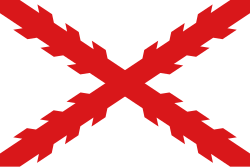Spanish West Florida
| Province of West Florida | |||||||||||||||
|---|---|---|---|---|---|---|---|---|---|---|---|---|---|---|---|
| Province of Viceroyalty of New Spain | |||||||||||||||
| 1783–1821 | |||||||||||||||
|
Arturo O'Neill de Tyrone | |||||||||||||||
• 1819–1821 | José María Callava | ||||||||||||||
| History | |||||||||||||||
| 10 February 1783 | |||||||||||||||
• Disestablished | 1821 | ||||||||||||||
| |||||||||||||||
Spanish West Florida (Spanish: Florida Occidental) was a province of the Spanish Empire from 1783 until 1821, when both it and East Florida were ceded to the United States.
The region of
History
Spain was the first European state to colonize the Florida peninsula, expanding northward from Cuba and establishing long-lasting settlements at St. Augustine, on the Atlantic coast, as well as at Pensacola and San Marcos (St. Marks), on the Gulf of Mexico coast.[1]
-
Map showing piecemeal reduction of Spanish control in West Florida[2]p 2
-
Annotated map of the territorial changes of Spanish West Florida[3]
-
Under Spanish rule, Florida was divided by the natural separation of the Suwannee River into West Florida and East Florida (map: Carey & Lea, 1822).
Following Spain's losses to
In 1779,
.In the 1783 Paris peace treaty, Great Britain returned both Florida colonies to Spanish control. Instead of administering Florida as a single province, as it had prior to 1763, New Spain preserved the British arrangement of dividing the territory between East and West Florida (Florida Oriental and Florida Occidental).[6] When Spain acquired West Florida in 1783, the eastern British boundary was the Apalachicola River, but Spain moved it eastward to the Suwannee River in 1785.[7][8] The purpose was to transfer San Marcos and the district of Apalachee from East Florida to West Florida.[9][10]
Population and demographics
When British West Florida surrendered to the Spanish, civilian residents of Pensacola were given the option of staying or leaving with most opting to leave. Pensacola primarily functioned as a British military garrison and most of its inhabitants were directly or indirectly involved with the garrison. At the time of the transfer of West Florida to the Spanish from the British the population of Pensacola excluding its military garrison was about 300. The population of Pensacola would grow, with the civilian population in 1788 being 265 and increasing to 572 by 1791. However, when Spain went to war in April of 1793 some residents left, reducing the population to 400. With the loss of Spanish Louisiana, the population grew further to 1,000 by 1810 and peaked in a census taken on June 13, 1813 at 3,063 people.[11]
Between where Pensacola ended and the American settlements began, control of the land was left to several Native American tribes: the Cherokee, the Chickasaw, the Choctaw and the Creek, which altogether had a population of 45,000.[11]
With the arrival of the Spanish in West Florida, they did not revive the
The Spanish aided the migration of the French Acadians to the colony's Louisiana bayous by subsidizing their "transportation, maintenance, and financial aid" between 1783 and 1785 and their migration to Louisiana resulted in the Cajun culture forming.[12]
See also
References
- ISBN 978-0-7614-2936-4.
- ^ Chambers, Henry E. (May 1898). West Florida and its relation to the historical cartography of the United States. Baltimore, Maryland: The Johns Hopkins Press.
- ^ Cox, Isaac Joslin (1918). The West Florida Controversy, 1798–1813 – a Study in American Diplomacy. Baltimore, Maryland: The Johns Hopkins Press.
isaac cox west florida.
- ISBN 978-0-8071-0579-5.)
{{cite book}}: CS1 maint: numeric names: authors list (link - ISBN 978-1-85109-697-8.
- ISBN 978-0-8203-2921-5.
- JSTOR 2502623. Wright also notes, "It was some time after 1785 before it was clearly established that Suwannee was the new eastern boundary of the province of Apalachee."
- ISBN 0300059175.
Spain never drew a clear line to separate the two Floridas, but West Florida extended easterly to include Apalachee Bay, which Spain shifted from the jurisdiction of St. Augustine to more accessible Pensacola.
- ^ "The Evolution of a State, Map of Florida Counties – 1820". 10th Circuit Court of Florida. Retrieved 2016-01-26.
Under Spanish rule, Florida was divided by the natural separation of the Suwanee River into West Florida and East Florida.
- ^ Klein, Hank. "History Mystery: Was Destin Once in Walton County?". The Destin Log. Retrieved 2016-01-26.
On July 21, 1821 all of what had been West Florida was named Escambia County, after the Escambia River. It stretched from the Perdido River to the Suwanee River with its county seat at Pensacola.
- ^ a b McAlister, L. N. (1958). "Pensacola During the Second Spanish Period". Florida Historical Quarterly. 37 (3–4). Retrieved September 2, 2023 – via STARS.
- ^ JSTOR 23914640. Retrieved September 2, 2023.
Bibliography
- Arthur, Stanley Clisby (1935). The Story of the West Florida Rebellion. St. Francisville Democrat. ) Reprint, Pioneer Publishing, 164 pp.
- Cox, Isaac Joslin (1918). The West Florida Controversy, 1798–1813: A Study in American Diplomacy. Baltimore, Md: The Johns Hopkins Press. OCLC 479174.
- Gannon, Michael (1996). The New History of Florida. University Press of Florida. ISBN 0-8130-1415-8.
- McMichael, Andrew (2008). Atlantic Loyalties: Americans in Spanish West Florida, 1785–1810. University of George Press. ISBN 978-0-8203-3004-4.
- West Florida Collection, Center for Southeast Louisiana Studies, Linus A. Sims Memorial Library, Southeastern Louisiana University, Hammond. For a summary of the holdings see West Florida Archival Collection


![Map showing piecemeal reduction of Spanish control in West Florida[2]p 2](http://upload.wikimedia.org/wikipedia/commons/thumb/f/fb/Westfloridaitsre00cham_0010.jpg/120px-Westfloridaitsre00cham_0010.jpg)
![Annotated map of the territorial changes of Spanish West Florida[3]](http://upload.wikimedia.org/wikipedia/commons/thumb/f/fe/Map_to_Illustrate_the_Acquisition_of_West_Florida.jpg/120px-Map_to_Illustrate_the_Acquisition_of_West_Florida.jpg)
